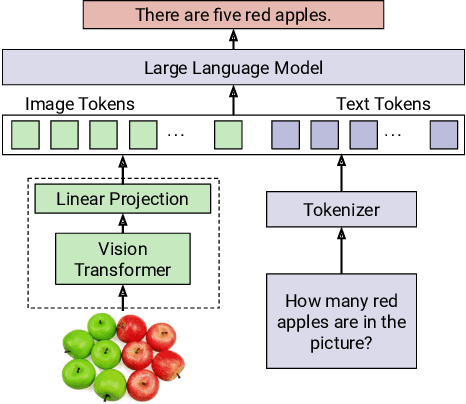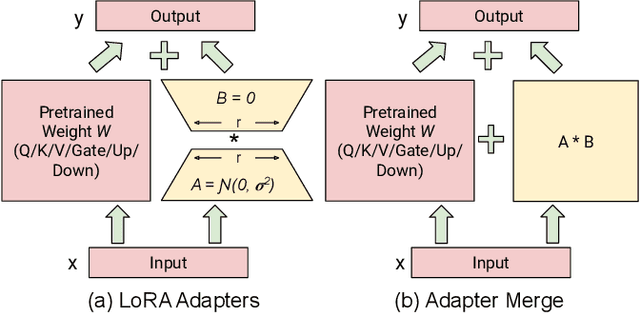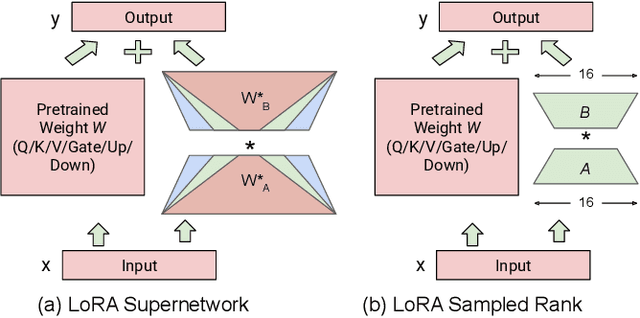Venkatram Vishwanath
PagedEviction: Structured Block-wise KV Cache Pruning for Efficient Large Language Model Inference
Sep 04, 2025Abstract:KV caching significantly improves the efficiency of Large Language Model (LLM) inference by storing attention states from previously processed tokens, enabling faster generation of subsequent tokens. However, as sequence length increases, the KV cache quickly becomes a major memory bottleneck. To address this, we propose PagedEviction, a novel fine-grained, structured KV cache pruning strategy that enhances the memory efficiency of vLLM's PagedAttention. Unlike existing approaches that rely on attention-based token importance or evict tokens across different vLLM pages, PagedEviction introduces an efficient block-wise eviction algorithm tailored for paged memory layouts. Our method integrates seamlessly with PagedAttention without requiring any modifications to its CUDA attention kernels. We evaluate PagedEviction across Llama-3.1-8B-Instruct, Llama-3.2-1B-Instruct, and Llama-3.2-3B-Instruct models on the LongBench benchmark suite, demonstrating improved memory usage with better accuracy than baselines on long context tasks.
MoE-Inference-Bench: Performance Evaluation of Mixture of Expert Large Language and Vision Models
Aug 24, 2025Abstract:Mixture of Experts (MoE) models have enabled the scaling of Large Language Models (LLMs) and Vision Language Models (VLMs) by achieving massive parameter counts while maintaining computational efficiency. However, MoEs introduce several inference-time challenges, including load imbalance across experts and the additional routing computational overhead. To address these challenges and fully harness the benefits of MoE, a systematic evaluation of hardware acceleration techniques is essential. We present MoE-Inference-Bench, a comprehensive study to evaluate MoE performance across diverse scenarios. We analyze the impact of batch size, sequence length, and critical MoE hyperparameters such as FFN dimensions and number of experts on throughput. We evaluate several optimization techniques on Nvidia H100 GPUs, including pruning, Fused MoE operations, speculative decoding, quantization, and various parallelization strategies. Our evaluation includes MoEs from the Mixtral, DeepSeek, OLMoE and Qwen families. The results reveal performance differences across configurations and provide insights for the efficient deployment of MoEs.
LangVision-LoRA-NAS: Neural Architecture Search for Variable LoRA Rank in Vision Language Models
Aug 17, 2025



Abstract:Vision Language Models (VLMs) integrate visual and text modalities to enable multimodal understanding and generation. These models typically combine a Vision Transformer (ViT) as an image encoder and a Large Language Model (LLM) for text generation. LoRA (Low-Rank Adaptation) is an efficient fine-tuning method to adapt pre-trained models to new tasks by introducing low-rank updates to their weights. While LoRA has emerged as a powerful technique for fine-tuning large models by introducing low-rank updates, current implementations assume a fixed rank, potentially limiting flexibility and efficiency across diverse tasks. This paper introduces \textit{LangVision-LoRA-NAS}, a novel framework that integrates Neural Architecture Search (NAS) with LoRA to optimize VLMs for variable-rank adaptation. Our approach leverages NAS to dynamically search for the optimal LoRA rank configuration tailored to specific multimodal tasks, balancing performance and computational efficiency. Through extensive experiments using the LLaMA-3.2-11B model on several datasets, LangVision-LoRA-NAS demonstrates notable improvement in model performance while reducing fine-tuning costs. Our Base and searched fine-tuned models on LLaMA-3.2-11B-Vision-Instruct can be found \href{https://huggingface.co/collections/krishnateja95/llama-32-11b-vision-instruct-langvision-lora-nas-6786cac480357a6a6fcc59ee}{\textcolor{blue}{here}} and the code for LangVision-LoRA-NAS can be found \href{https://github.com/krishnateja95/LangVision-NAS}{\textcolor{blue}{here}}.
AI Assistants to Enhance and Exploit the PETSc Knowledge Base
Jun 25, 2025Abstract:Generative AI, especially through large language models (LLMs), is transforming how technical knowledge can be accessed, reused, and extended. PETSc, a widely used numerical library for high-performance scientific computing, has accumulated a rich but fragmented knowledge base over its three decades of development, spanning source code, documentation, mailing lists, GitLab issues, Discord conversations, technical papers, and more. Much of this knowledge remains informal and inaccessible to users and new developers. To activate and utilize this knowledge base more effectively, the PETSc team has begun building an LLM-powered system that combines PETSc content with custom LLM tools -- including retrieval-augmented generation (RAG), reranking algorithms, and chatbots -- to assist users, support developers, and propose updates to formal documentation. This paper presents initial experiences designing and evaluating these tools, focusing on system architecture, using RAG and reranking for PETSc-specific information, evaluation methodologies for various LLMs and embedding models, and user interface design. Leveraging the Argonne Leadership Computing Facility resources, we analyze how LLM responses can enhance the development and use of numerical software, with an initial focus on scalable Krylov solvers. Our goal is to establish an extensible framework for knowledge-centered AI in scientific software, enabling scalable support, enriched documentation, and enhanced workflows for research and development. We conclude by outlining directions for expanding this system into a robust, evolving platform that advances software ecosystems to accelerate scientific discovery.
HiPerRAG: High-Performance Retrieval Augmented Generation for Scientific Insights
May 07, 2025Abstract:The volume of scientific literature is growing exponentially, leading to underutilized discoveries, duplicated efforts, and limited cross-disciplinary collaboration. Retrieval Augmented Generation (RAG) offers a way to assist scientists by improving the factuality of Large Language Models (LLMs) in processing this influx of information. However, scaling RAG to handle millions of articles introduces significant challenges, including the high computational costs associated with parsing documents and embedding scientific knowledge, as well as the algorithmic complexity of aligning these representations with the nuanced semantics of scientific content. To address these issues, we introduce HiPerRAG, a RAG workflow powered by high performance computing (HPC) to index and retrieve knowledge from more than 3.6 million scientific articles. At its core are Oreo, a high-throughput model for multimodal document parsing, and ColTrast, a query-aware encoder fine-tuning algorithm that enhances retrieval accuracy by using contrastive learning and late-interaction techniques. HiPerRAG delivers robust performance on existing scientific question answering benchmarks and two new benchmarks introduced in this work, achieving 90% accuracy on SciQ and 76% on PubMedQA-outperforming both domain-specific models like PubMedGPT and commercial LLMs such as GPT-4. Scaling to thousands of GPUs on the Polaris, Sunspot, and Frontier supercomputers, HiPerRAG delivers million document-scale RAG workflows for unifying scientific knowledge and fostering interdisciplinary innovation.
AdaParse: An Adaptive Parallel PDF Parsing and Resource Scaling Engine
Apr 23, 2025Abstract:Language models for scientific tasks are trained on text from scientific publications, most distributed as PDFs that require parsing. PDF parsing approaches range from inexpensive heuristics (for simple documents) to computationally intensive ML-driven systems (for complex or degraded ones). The choice of the "best" parser for a particular document depends on its computational cost and the accuracy of its output. To address these issues, we introduce an Adaptive Parallel PDF Parsing and Resource Scaling Engine (AdaParse), a data-driven strategy for assigning an appropriate parser to each document. We enlist scientists to select preferred parser outputs and incorporate this information through direct preference optimization (DPO) into AdaParse, thereby aligning its selection process with human judgment. AdaParse then incorporates hardware requirements and predicted accuracy of each parser to orchestrate computational resources efficiently for large-scale parsing campaigns. We demonstrate that AdaParse, when compared to state-of-the-art parsers, improves throughput by $17\times$ while still achieving comparable accuracy (0.2 percent better) on a benchmark set of 1000 scientific documents. AdaParse's combination of high accuracy and parallel scalability makes it feasible to parse large-scale scientific document corpora to support the development of high-quality, trillion-token-scale text datasets. The implementation is available at https://github.com/7shoe/AdaParse/
Quality Measures for Dynamic Graph Generative Models
Mar 03, 2025Abstract:Deep generative models have recently achieved significant success in modeling graph data, including dynamic graphs, where topology and features evolve over time. However, unlike in vision and natural language domains, evaluating generative models for dynamic graphs is challenging due to the difficulty of visualizing their output, making quantitative metrics essential. In this work, we develop a new quality metric for evaluating generative models of dynamic graphs. Current metrics for dynamic graphs typically involve discretizing the continuous-evolution of graphs into static snapshots and then applying conventional graph similarity measures. This approach has several limitations: (a) it models temporally related events as i.i.d. samples, failing to capture the non-uniform evolution of dynamic graphs; (b) it lacks a unified measure that is sensitive to both features and topology; (c) it fails to provide a scalar metric, requiring multiple metrics without clear superiority; and (d) it requires explicitly instantiating each static snapshot, leading to impractical runtime demands that hinder evaluation at scale. We propose a novel metric based on the \textit{Johnson-Lindenstrauss} lemma, applying random projections directly to dynamic graph data. This results in an expressive, scalar, and application-agnostic measure of dynamic graph similarity that overcomes the limitations of traditional methods. We also provide a comprehensive empirical evaluation of metrics for continuous-time dynamic graphs, demonstrating the effectiveness of our approach compared to existing methods. Our implementation is available at https://github.com/ryienh/jl-metric.
BaKlaVa -- Budgeted Allocation of KV cache for Long-context Inference
Feb 18, 2025Abstract:In Large Language Model (LLM) inference, Key-Value (KV) caches (KV-caches) are essential for reducing time complexity. However, they result in a linear increase in GPU memory as the context length grows. While recent work explores KV-cache eviction and compression policies to reduce memory usage, they often consider uniform KV-caches across all attention heads, leading to suboptimal performance. We introduce BaKlaVa, a method to allocate optimal memory for individual KV-caches across the model by estimating the importance of each KV-cache. Our empirical analysis demonstrates that not all KV-caches are equally critical for LLM performance. Using a one-time profiling approach, BaKlaVa assigns optimal memory budgets to each KV-cache. We evaluated our method on LLaMA-3-8B, and Qwen2.5-7B models, achieving up to a 70\% compression ratio while keeping baseline performance and delivering up to an order-of-magnitude accuracy improvement at higher compression levels.
A Deep Probabilistic Framework for Continuous Time Dynamic Graph Generation
Dec 20, 2024



Abstract:Recent advancements in graph representation learning have shifted attention towards dynamic graphs, which exhibit evolving topologies and features over time. The increased use of such graphs creates a paramount need for generative models suitable for applications such as data augmentation, obfuscation, and anomaly detection. However, there are few generative techniques that handle continuously changing temporal graph data; existing work largely relies on augmenting static graphs with additional temporal information to model dynamic interactions between nodes. In this work, we propose a fundamentally different approach: We instead directly model interactions as a joint probability of an edge forming between two nodes at a given time. This allows us to autoregressively generate new synthetic dynamic graphs in a largely assumption free, scalable, and inductive manner. We formalize this approach as DG-Gen, a generative framework for continuous time dynamic graphs, and demonstrate its effectiveness over five datasets. Our experiments demonstrate that DG-Gen not only generates higher fidelity graphs compared to traditional methods but also significantly advances link prediction tasks.
LLM-Inference-Bench: Inference Benchmarking of Large Language Models on AI Accelerators
Oct 31, 2024Abstract:Large Language Models (LLMs) have propelled groundbreaking advancements across several domains and are commonly used for text generation applications. However, the computational demands of these complex models pose significant challenges, requiring efficient hardware acceleration. Benchmarking the performance of LLMs across diverse hardware platforms is crucial to understanding their scalability and throughput characteristics. We introduce LLM-Inference-Bench, a comprehensive benchmarking suite to evaluate the hardware inference performance of LLMs. We thoroughly analyze diverse hardware platforms, including GPUs from Nvidia and AMD and specialized AI accelerators, Intel Habana and SambaNova. Our evaluation includes several LLM inference frameworks and models from LLaMA, Mistral, and Qwen families with 7B and 70B parameters. Our benchmarking results reveal the strengths and limitations of various models, hardware platforms, and inference frameworks. We provide an interactive dashboard to help identify configurations for optimal performance for a given hardware platform.
 Add to Chrome
Add to Chrome Add to Firefox
Add to Firefox Add to Edge
Add to Edge